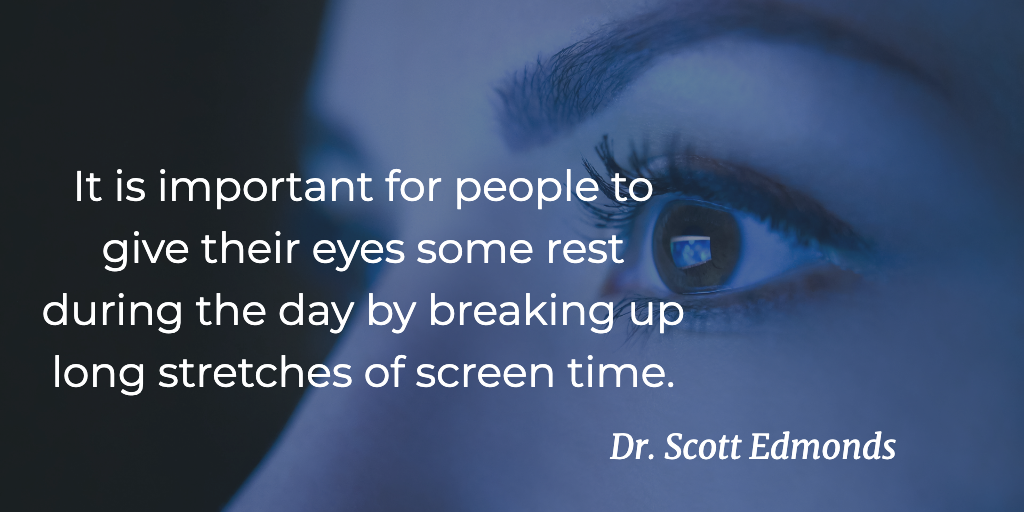5 tips to help block blue light in an increasingly remote world
As consistent use of digital devices remains a fact of life for people of virtually all ages, consider this expert advice

With persistent spread of the virus that causes COVID-19 nationwide, some traditionally in-person activities—work, school, and social interactions—will likely remain remote more often than usual for the foreseeable future.
As a result, the use of digital devices has surged significantly as people spend more time at home, with Americans logging an average of 13 hours per day watching screens.
That compares to between seven and 10 hours per day before the COVID-19 pandemic started, with the increase in screen time likely contributing to more exposure to blue light.
While this low-wavelength, high-energy light offers some benefits, such as boosting alertness and elevating moods, too much of it may cause problems.
Edmonds

Researchers continue to evaluate the potential short- and long-term health implications that may come from excessive exposure to blue light, including potential damage to retina cells, particularly in children and teens; increased incidences of age-related macular degeneration (AMD); disrupted sleep cycles; and digital eye strain.
Here are five eye health tips to consider as the consistent use of digital devices remains a fact of life for people of virtually all ages:
1. Look for warning signs of digital eye strain.
Nearly 60% of U.S. adults report experiencing symptoms of digital eye strain, which may result from extended computer and smartphone usage and can contribute to dry eyes, headaches and neck or shoulder pain.
For parents, it is important to look out for digital eye strain and other signs of vision problems, as children may not be aware and won’t complain if their eyesight isn’t normal. Red flags may include squinting while reading or watching television, or difficulty hitting or catching a ball while playing sports. These issues can indicate an underlying vision problem that might require glasses or other treatments from an eye care professional.
2. Set screens at a proper distance.
Many people find it comfortable to view a screen while looking slightly downward—a few inches below eye level—and positioning the device at least 30 inches from their eyes, as this separation can help reduce blue light exposure.
Keeping this distance is especially important for children, as young people often hold digital devices closer to their faces than adults do—thus potentially leading to a higher amount of blue light. For people with computer-based jobs, it may be helpful to place reference documents so their head does not need to be repositioned to see them, such as above the keyboard, below the monitor, or on a document holder.

3. Use the 20-20-20 rule or other rest tactics.
It is important for people to give their eyes some rest during the day by breaking up long stretches of screen time. The 20-20-20 rule recommends that after 20 minutes of computer work, people take 20 seconds to look at something that’s approximately 20 feet away. Another strategy is to switch to a task for which their eyes don't have to focus on something up close, such as returning a call, connecting with a coworker, or taking a walk.
Further, getting outside and away from digital screens may reduce the risk of developing nearsightedness, which has become increasingly common in part due to the increased use of screens, and today affects 41% of Americans—up from 25% in 1970.
4. Leverage blue-light-blocking technology.
Many smartphones now include a “night mode” feature, which adjusts the screen’s setting to help filter out blue light. Likewise, specialized screen protectors can feature blue-light-filtering properties, while also helping to prevent cracks or scratches.
To help block blue light at the source, some computer manufacturers are embedding blue-light-filtering technology into the screens, helping ensure color clarity while reducing exposure to blue light. Another option is to get glasses with premium anti-reflective coating, which may help prevent harmful reflective glare and reduce the risk of digital eye strain.
As part of a collaboration with Dell Technologies, UnitedHealthcare Vision recently announced an enhancement to an eye care program to help people reduce excessive exposure to high-energy blue light. Over 23 million UnitedHealthcare vision members nationwide now have access to a discount of up to 20% on Dell XPS laptops with embedded blue-light-filtering properties, and are also eligible for a comparable discount on Eyesafe Blue Light Screen Filters to retrofit their digital devices, including smartphones, monitors, and tablets. Through this innovative program, UnitedHealthcare hopes to continue to support overall eye health and help curtail the prevalence of digital eye strain.
5. Get a comprehensive eye exam.
It’s a good idea for computer users to get an eye exam every year, according to the American Optometric Association. If people experience ongoing symptoms of digital eye strain, prescription lenses for computer viewing may be needed. Plus, a comprehensive eye exam may uncover other health conditions not usually associated with the eyes, including diabetes and even some types of cancer. For children, it’s important to remember that a school’s vision check is not a substitute for a comprehensive eye exam, as screenings usually focus on measuring acuity levels and might miss common conditions such as poor eye alignment, focusing problems and farsightedness.
As we contend with the ongoing pandemic and transition to an increasingly virtual world, considering these tips can help people maintain or improve their eye health as part of an overall focus on whole-person well-being.
Newsletter
Want more insights like this? Subscribe to Optometry Times and get clinical pearls and practice tips delivered straight to your inbox.